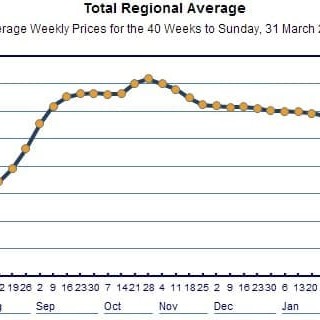 DIESEL fuel prices in regional and rural areas of Australia have started to ease from recent highs seen in mid-February, ending last month about 1.5c/litre lower, according to industry reports.
DIESEL fuel prices in regional and rural areas of Australia have started to ease from recent highs seen in mid-February, ending last month about 1.5c/litre lower, according to industry reports.
The adjustment is getting closer to relatively stable prices seen for a lengthy period last year at around 152c, before prices start to rise sharply during January. At their peak in February, the non-metropolitan regional average price for diesel across Australia was above 155c/litre, but had fallen to 153.4c/l by the end of last month.
The graph here is based on weekly price reporting information up to the week ended March 31, drawn from regional areas across the nation and released by the Australian Institute of Petroleum.
Prices in country areas last week were a mixed bag compared with February, with some well-up, while others were well-down. Biggest price falls were seen in Victoria and South Australia, while biggest rises were seen in the NT and Tasmania. Overall, however, the trend was down.
Regional non-metro diesel prices in the latest AIP report included:
- Victoria 150.7c/l (down 0.8c/litre since mid-February)
- NSW 152.9c (down 0.4c)
- Queensland 153c (down 0.6c)
- WA 157.7c (up 0.2c)
- SA 152.2c (down 1.7c)
- TAS 157.2c (up 0.4c), and
- NT 170.2c (up 1.4c).
The prices are calculated as a weighted average of retail diesel fuel for country regions in each state/territory. All values include GST.
Variation in fuel prices can have a considerable impact of cost of production across the Australian beef industry, impacting on livestock transport, cost of shipping in live cattle and boxed beef exports, pumping stock water and providing station electricity in remote locations.
Crude oil, diesel and petrol prices are closely linked, as the price of crude oil accounts for the majority of the cost of producing a litre of petrol or diesel. Crude oil is purchased in US$, meaning that changes in the value of the A$ against the US have a direct impact on the relative price of crude oil in A$ terms.
Further price rises may again be on the horizon, however. Crude oil futures prices breached nine-month highs in early February as improved economic signals emerged from China and the US, robust financial market activity and colder temperatures in the Northern Hemisphere signalled a rise in fuel demand.
The most likely cause of a future increase in world oil prices, and thus diesel fuel prices, is a return to stronger growth in the world economy, energy commentators say.
The performance of China will be a big part of that. The optimists about China expect economic growth at a rate of 10pc or more, while the pessimists think that growth could fall below 7pc. Either way, China will be burning more oil and diesel this year, and that’s also true for other major Asian economies, such as India and Indonesia.
Growth in the developed world is less certain. Europe remains in recession now, with a major uncertainty about the timing of its recovery. American economic growth is light-to-moderate, at best, while Japan’s economy remains stagnant.
- Click on the image here for a larger view of recent regional Australian diesel price trends.
